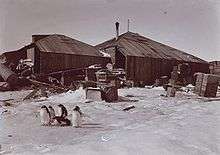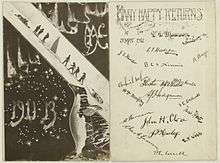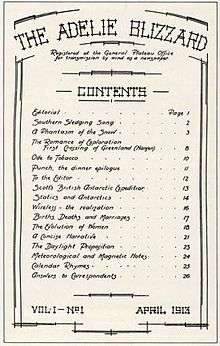Australasian Antarctic Expedition


The Australasian Antarctic Expedition (AAE) was an Australasian scientific team that explored part of Antarctica between 1911 and 1914. It was led by the Australian geologist Douglas Mawson, who was knighted for his achievements in leading the expedition. In 1910 he began to plan an expedition to chart the 3,200-kilometre-long (2,000 mi) coastline of Antarctica to the south of Australia. The Australasian Association for the Advancement of Science approved of his plans and contributed substantial funds for the expedition.
Accomplishments were made in geology, glaciology and terrestrial biology, unlike both of Ernest Shackleton's following expeditions which produced very little science.[1] In a celebration of the achievements of Mawson and his men, a centenary scientific voyage, retracing the route of the original expedition, departed from Australasia in late 2013 and became stuck on 24 December 2013.[2]
History
Preparations
The team selected for the expedition came primarily from universities in Australia and New Zealand. Of the men who would occupy bases on the Antarctic continent, twenty-two were Australian residents. Four were New Zealanders, three British and one Swiss. Three of the leaders (Mawson, Wild and Davis) were veterans of other Antarctic voyages.
They would sail on the Newfoundland sealing vessel Aurora, a steam-powered sailing vessel with a length of 50 metres (165 ft) and a displacement of 600 tons. The ship underwent modifications for the trip, including adding three large tanks for storing fresh water. The Aurora captain was John King Davis.
The vessel departed for Macquarie Island on 2 December 1911,[3] arriving on 11 December after surviving stormy weather during the crossing. A second vessel, the Toroa, followed with supplies and passengers. Departing Macquarie Island on 23 December, the Aurora began exploring the coastal areas, during which the vessel and its men discovered and named King George V Land and Queen Mary Land.

Key members of the expedition included Frank Hurley as official photographer, Frank Wild as leader of the western base, Charles Hoadley as geologist, and Cecil Madigan as meteorologist.
Other members of the expedition included Edward Bage, Frank Bickerton, Leslie Russell Blake, Sidney Jeffryes, Charles Laseron, Archibald McLean, Herbert Dyce Murphy, Frank Stillwell and Leslie Whetter .
Base camps
The expedition built their main base, or winter quarters, at Cape Denison in Commonwealth Bay, where eighteen men spent the winter of 1912 and seven spent the winter of 1913. (Their huts still stand – two intact and two as ruins: Mawson's Huts, now managed as an historic site by the Australian Antarctic Division). They also built two auxiliary bases, a support base and wireless relay station on Macquarie Island initially headed by George Ainsworth, and a western base on the Shackleton Ice Shelf, but these two auxiliary bases no longer survive.
The teams at all three bases conducted routine scientific and meteorological observations, which were recorded in great detail in the voluminous reports of the expedition (not published until 1922–1942). They also overcame months of failures with equipment and masts by eventually establishing the first Antarctic wireless radio connection (linked to Hobart via a radio relay station established at Wireless Hill on Macquarie Island).[4]
Three short film clips from the official film of the expedition eventually entitled The Home of the Blizzard can be found online here. An extensive critique of the final film appears on the NFSA page in two parts. Part One and Part Two. A 15-minute 3-D version of Frank Hurley's still photographs from the expedition is also available online here.
Sledging expeditions


Coastal and inland sledging journeys enabled the teams to explore previously unknown lands. In the second half of 1912, there were five major journeys from the main base and two from the western base.
Mawson himself was part of a three-man sledging team, the Far Eastern Party, with Xavier Mertz, and Lieutenant B. E. S. Ninnis who headed east on 10 November 1912 to survey King George V Land. On 14 December 1912,[5] after three weeks of excellent progress, the party was crossing the Ninnis Glacier, when Ninnis fell through a snow-covered crevasse. Mertz had skied over the crevasse lid, Mawson had been on his sled with his weight dispersed, but Ninnis was jogging beside the second sled and his body weight is likely to have breached the lid. Six dogs, most of the party's rations, their tent and other essential supplies disappeared into a massive crevasse 480 km east of the main base. Mertz and Mawson spotted one dead and one injured dog on a ledge 46m down but Ninnis was never seen again.[6]
Mawson and Xavier Mertz turned back immediately. Their scanty provisions forced them to eat their remaining sled dogs, unwittingly causing a quick deterioration in the men's physical condition. The liver of one dog contains enough vitamin A to produce the condition called Hypervitaminosis A. Mertz became incapacitated and incoherent; in an attempt to nurse him back to health, Mawson fed him most of the dog livers, which he considered more nourishing than the tough muscle tissue. After Mertz died, Mawson continued alone for 30 days.[7] He cut his sled in half with a pen knife and dragged the sled with geological specimens but minimal food 160 km back to the base at Cape Denison. During the return trip to the Main Base, he fell through the lid of a crevasse and was saved only by his sledge wedging itself into the ice above him. When Mawson finally made it back to Cape Denison on 8 February 1913 the words of his first rescuer upon finding Mawson were, "My God, which one are you?"[8] However it was just hours after Davis's recovery party had left on the Aurora. The ship was recalled by wireless communication, only to have bad weather thwart the rescue effort. Mawson, and six men who had remained behind to look for him, wintered a second unplanned year until December 1913.

In order to maintain morale over the prolonged period of isolation Archie Maclean hit upon the idea of publishing their own newspaper to keep the confined men entertained. Expedition members contributed poetry, short fiction, and literary criticism as well as scientific articles and accounts of their daily activities. The result was the Adelie Blizzard which had five issues between April and October in 1913. They were never officially published for the general public until almost 100 years had passed when a facsimile edition was produced.
Geology

As the expedition commander Douglas Mawson was himself a geologist, the examination of the accessible (i.e., not covered by ice) rock formations of Wilkes Land was a key feature of the expedition.
The expedition is noted for having achieved the first discovery of a meteorite, a chondrite, 30 km west of Cape Denison.[9] Over the following century a trove of meteorites have been discovered in this region of Antarctica.
Meteorology
The location chosen by Mawson for the main base camp, at Cape Denison, proved to be one of the places on Earth with the strongest wind forces, with local morphology – the abrupt gradient between the East Antarctic ice plateau and the Antarctic Ocean – creating conditions ripe for the generation of near-continuous katabatic wind conditions.[10]
Communications
The Aurora carried a Marconi wireless set and another was set up at Cape Denison, but due to the competitive nature of Antarctic exploration at the time transmissions were kept to an absolute minimum. The equipment used was a 1.5Kw Telefunken spark transmitter and a flat top antenna. Atmospheric conditions associated with the Aurora Australis interfered with radio transmissions on many occasions, but the expedition parties were generally able to receive news from the outside world reasonably regularly via the relay station on Macquarie Island.[11]
See also
References
- ↑ National Research Council (U.S.), Pola Research Board (1986). Antarctic Treaty System: An assessment. National Academies. p. 96. Retrieved 18 January 2012.
- ↑ "Polar trek made to measure where Mawson team made mark". The Age. 30 September 2013.
- ↑ "100 years of Australian Antarctic Expeditions". About the centenary. Department of Environment. Retrieved 13 June 2014.
- ↑ Yates, Peter. "Australia continues as telecommunications innovator". Australian Antarctic Magazine. Spring 2001 (2). Retrieved 13 June 2014.
- ↑ Roberts, David (January 2013). "Into the Unknown". National Geographic. Retrieved 29 January 2013.
- ↑ "Antarctic Explorers: Douglas Mawson". www.south-pole.com. Retrieved 18 January 2012.
- ↑ "Sir Douglas Mawson (1882–1958)". About Antarctica. Department of the Environment. Retrieved 13 June 2014.
- ↑ Bickel, Lennard (2000). Mawson's Will: The Greatest Polar Survival Story Ever Written. Hanover, New Hampshire: Steerforth Press. ISBN 1-58642-000-3.
- ↑ Sears, Derek (22 March 1979). "Rocks on the ice". New Scientist. 81 (1147): 959. ISSN 0262-4079. Retrieved 18 January 2012.
- ↑ "Cape Denison, the birthplace of Australian Antarctic expeditions". AusGeo News. Commonwealth of Australia. December 2011. Retrieved 13 June 2014.
- ↑ Taylor, Stanley Gordon Roberts. "Antarctic Diary". Stanley Gordon Roberts Taylor's diary of his 1912–1913 voyage to Antarctica with Sir Douglas Mawson's Australasian Antarctic Expedition. Taylor family. Retrieved 7 April 2014.
Further reading
- Mawson, Douglas (1915), The Home of the Blizzard; Being the Story of the Australasian Antarctic Expedition, 1911–1914, Philadelphia, Lippincott.
- Mawson, Douglas (1918), Scientific Reports: Vol. 3, Pt. 1–6, Sydney: Govt. Printer.
- Hall, Lincoln, (2000), Douglas Mawson : the life of an explorer, French's Forest, N.S.W. : New Holland
- McEwin, Emma (2008), An Antarctic affair : a story of love and survival by the great-granddaughter of Douglas and Paquita Mawson, Bowden, SA : East Street Publications
- Roberts, David (2013), Alone on the ice : the greatest survival story in the history of exploration, New York : W.W. Norton & Co
- Davis, John King [1919], With the "Aurora" in the Antarctic 1911–1914, London, Andrew Melrose Ltd.
- Turney, Chris (2013), 1912: The Year The World Discovered Antarctica, Text Publishing, Melbourne.
- Benham, William Blaxland Shoppee (1921), Polychaeta, [Sydney] : Australasian Antarctic Expedition.
- Khler, René (1922), Echinodermata Ophiuroidea, Sydney : Printed by John Spence, acting government printer.
- Bickel, Lennard (2000). Mawson's Will: The Greatest Polar Survival Story Ever Written. Teerforth Press. ISBN 1-58642-000-3.
- The Friends of the State Library of South Australia in association with the Friends of Mawson at the South Australian Museum (2010), The Adelie Blizzard : Mawson's forgotten newspaper 1913
- Dartnall, Herbert J. G. (2014), Lost in the mists : Leslie Russell Blake : Mawson's cartographer and hero of Pozières, North Melbourne, Vic : Australian Scholarly
- Madigan, C.T. Madigan's account : the Mawson expedition : the Antarctic diaries of C.T. Madigan, 1911–1914 / transcribed by J.W. Madigan. [North Hobart, Tasmania] Wellington Bridge Press
External links
| Wikimedia Commons has media related to Australasian Antarctic Expedition. |
- Mawson's Huts Historic Site Management Plan 2007–2012 (Australian Antarctic Division)
- The Australasian Antarctic Expedition 2013–2014 (In the Spirit of Mawson)
- Diary of Stan Taylor, Seaman on the Aurora 1912 -1913 journey
- The Home of the Blizzard at Project Gutenberg
- Mawson and Mertz: a re-evaluation of their ill-fated mapping journey during the 1911–1914 Australasian Antarctic Expedition – examining the Vitamin A poisoning hypothesis.